Research on the Compound Jamming Method against FDA-MIMO Beamforming
Abstract
:1. Introduction
- (1)
- An accurate understanding of the FDA-MIMO range dimension jamming method is proposed, and its jamming model is analyzed;
- (2)
- A compound jamming method of suppression and range deceptive against FDA-MIMO beamforming is proposed. This method can reasonably utilize the beam gain and the minimum variance distortionless response (MVDR) adaptive beamforming algorithm cannot significantly reduce the power of jamming, causing a significant compound jamming effect to radar in the range dimension;
- (3)
- For the proposed compound jamming method, it is analyzed at the range bin estimation level and its signal to interference plus noise ratio (SINR) is compared and analyzed. The results show that it can form an effective compound jamming effect.
2. FDA-MIMO Basic Principle and Jamming Model
2.1. Basic Principle of FDA-MIMO
2.2. Jamming Model against FDA-MIMO
3. MVDR Adaptive Beamforming Algorithm
4. Jamming Methods and Models
5. Simulation Analysis
5.1. Beamforming Gain Analysis
5.2. Range Bin Analysis Results
6. Conclusions
- (1)
- By studying the FDA-MIMO deceptive jamming model, an effective jamming method against FDA-MIMO radar was analyzed;
- (2)
- A suppression and range deceptive compound jamming method against FDA-MIMO beamforming was proposed. The beamforming gain and range bin estimation level were simulated and analyzed. Compared with the existing deceptive jamming methods, the proposed jamming method can obtain the same beam gain as the target, and it can produce a significant compound jamming effect for the range parameter estimation performance of FDA-MIMO radar;
- (3)
- The simulation results showed that the output SINR of the proposed jamming increased more slowly, and when the input SINR was 10 dB, the output SINR was also about 10dB, and the output SINR could always be kept at a low level, so the proposed jamming method can produce an effective compound jamming effect, and the jamming effect was good.
Author Contributions
Funding
Institutional Review Board Statement
Informed Consent Statement
Data Availability Statement
Conflicts of Interest
References
- Antonik, P.; Wicks, M.C.; Griffiths, H.D.; Baker, C.J. Frequency diverse array radars. In Proceedings of the 2006 IEEE Conference on Radar, Verona, NY, USA, 24–27 April 2006. [Google Scholar]
- Wang, W.Q. Range-Angle Dependent Transmit Beampattern Synthesis for Linear Frequency Diverse Arrays. IEEE Trans. Antennas Propag. 2013, 61, 4073–4081. [Google Scholar] [CrossRef]
- Xu, J.W.; Zhu, S.Q.; Liao, G.S.; Zhang, Y.H. An Overview of Frequency Diverse Array Radar Technology. J. Radars 2018, 7, 167–182. [Google Scholar]
- Wang, W.Q.; Chen, H.; Zheng, Z.; Zhang, S.S. Advances on Frequency Diverse Array Radar and Its Applications. J. Radars 2018, 7, 153–166. [Google Scholar]
- Lan, L.; Xu, J.W.; Zhu, S.Q.; Liao, G.S.; Zhang, Y.H. Advances in anti-jamming using waveform diverse array radar. Syst. Eng. Electron. 2021, 43, 1437–1451. [Google Scholar]
- Sammartino, P.F.; Baker, C.J.; Griffiths, H.D. Frequency Diverse MIMO Techniques for Radar. IEEE Trans. Aerosp. Electron. Syst. 2013, 49, 201–222. [Google Scholar] [CrossRef]
- Xu, J.W.; Liao, G.S.; Zhu, S.Q.; Huang, L.; So, H.C. Joint Range and Angle Estimation Using MIMO Radar With Frequency Diverse Array. IEEE Trans. Signal Process. 2015, 63, 3396–3410. [Google Scholar] [CrossRef]
- Wang, W.Q. Overview of frequency diverse array in radar and navigation applications. IET Radar Sonar Navig. 2016, 10, 1001–1012. [Google Scholar] [CrossRef]
- Zhu, S.Q.; Yu, K.; Xu, J.W.; Lan, L.; Li, X.M. Research Progress and Prospect for the Noval Waveform Diverse Array Radar. J. Radars 2021, 10, 795–810. [Google Scholar]
- Wan, P.F.; Weng, Y.L.; Xu, J.W.; Liao, G.S. Range Gate Pull-Off Mainlobe Jamming Suppression Approach with FDA-MIMO Radar: Theoretical Formalism and Numerical Study. Remote Sens. 2022, 14, 1499. [Google Scholar] [CrossRef]
- Huang, L.B.; Zong, Z.L.; Zhang, S.S.; Wang, W.Q. 2-D Moving Target Deception Against Multichannel SAR-GMTI Using Frequency Diverse Array. IEEE Geosci. Remote Sens. Lett. 2022, 19, 1–5. [Google Scholar] [CrossRef]
- Liu, W.J.; Liu, J.; Hao, C.P.; Gao, Y.C.; Wang, Y.L. Multichannel adaptive signal detection: Basic theory and literature review. Sci. China Inf. Sci. 2022, 65, 5–44. [Google Scholar] [CrossRef]
- Chen, H.; Liu, Y.N.; Lv, M.J.; Zhang, X.W.; Xia, B.; Xie, D. Networked FDA-MIMO radar positioning to suppress dense false target jamming. J. Phys. Conf. Ser. 2021, 1920, 012061. [Google Scholar] [CrossRef]
- Ding, Z.H.; Xie, J.W.; Wang, B.; Zhang, H.W. Robust Adaptive Null Broadening Method Based on FDA-MIMO Radar. IEEE Access 2020, 8, 177976–177983. [Google Scholar] [CrossRef]
- Zhou, C.L.; Wang, C.Y.; Gong, J.; Tan, M.; Zhao, Y.J.; Liu, M.J. FDA-MIMO Beampattern Synthesis with an Analytical Method. Int. J. Aerosp. Eng. 2021, 2021, 1–11. [Google Scholar] [CrossRef]
- Xu, J.W.; Liao, G.S.; Zhu, S.Q.; So, H.C. Deceptive jamming suppression with frequency diverse MIMO radar. Signal Process. 2015, 113, 9–17. [Google Scholar] [CrossRef]
- Wen, C.; Peng, J.Y.; Zhou, Y.; Wu, J.X. Enhanced Three-Dimensional Joint Domain Localized STAP for Airborne FDA-MIMO Radar Under Dense False-Target Jamming Scenario. IEEE Sens. J. 2018, 18, 4154–4166. [Google Scholar] [CrossRef]
- Shi, J.T.; Liu, X.; Yang, Y.H.; Sun, J.; Wang, N. Comments on “Deceptive jamming suppression with frequency diverse MIMO radar”. Signal Process. 2019, 158, 1–3. [Google Scholar] [CrossRef]
- Wang, B.; Xie, J.W.; Ge, J.A.; Zhang, J. Angle deception effect of FDA on amplitude comparison direction finding system with single pulse. J. Beijing Univ. Aeronaut. Astronaut. 2020, 46, 643–650. [Google Scholar]
- Tan, M.; Wang, C.Y.; Xue, B.; Xu, J.W. A Novel Deceptive Jamming Approach Against Frequency Diverse Array Radar. IEEE Sens. J. 2021, 21, 8323–8332. [Google Scholar] [CrossRef]
- Zhao, Y.J.; Tian, B.; Wang, C.Y.; Gong, J.; Tan, M.; Zhou, C.L. Research on main-lobe deceptive jamming against FDA-MIMO radar. IET Radar Sonar Navig. 2021, 15, 641–654. [Google Scholar] [CrossRef]
- Shahid, M.; Aqdas, N.M.; Ijaz, M.Q.; Muhammad, Z.U.K.; Fawad, Z. A Novel Deceptive Jamming Approach for Hiding Actual Target and Generating False Targets. Wirel. Commun. Mob. Comput. 2021, 2021, 1–20. [Google Scholar]
- Zhao, Y.J.; Tian, B.; Wang, C.Y.; Gong, J.; Tan, M. Robust adaptive beamforming via improved worst-case performance optimization algorithm based on FDA-MIMO. Multidimens. Syst. Signal Process. 2022, 33, 725–746. [Google Scholar] [CrossRef]
- Lan, L.; Liao, G.S.; Xu, J.W.; Zhu, S.Q.; Zhang, Y.H. Range-angle-dependent beamforming for FDA-MIMO radar using oblique projection. Sci. China Inf. Sci. 2022, 65, 223–241. [Google Scholar] [CrossRef]
- Sun, Q.Y.; Shu, T.; Yu, K.B.; Yu, W.X. Efficient Deceptive Jamming Method of Static and Moving Targets Against SAR. IEEE Sens. J. 2018, 18, 3610–3618. [Google Scholar] [CrossRef]
- Gui, R.H.; Huang, B.; Wang, W.Q.; Sun, Y. Generalized Ambiguity Function for FDA Radar Joint Range, Angle and Doppler Resolution Evaluation. IEEE Geosci. Remote Sens. Lett. 2022, 19, 1–5. [Google Scholar] [CrossRef]
- Huang, L.B.; Li, X.; Wan, W.T.; Zhang, S.S.; Wang, W.Q. Frequency Diverse Array Introduced Into SAR GMTI to Mitigate Blind Velocity and Doppler Ambiguity. IEEE Geosci. Remote Sens. Lett. 2022, 19, 1–5. [Google Scholar] [CrossRef]
- Huang, B.; Wang, W.Q.; Zhang, S.S.; Wang, H.; Gui, R.H.; Lu, Z. A Novel Approach for Spaceborne SAR Scattered-Wave Deception Jamming Using Frequency Diverse Array. IEEE Geosci. Remote Sens. Lett. 2020, 17, 1568–1572. [Google Scholar] [CrossRef]
- Huang, B.; Wang, W.Q.; Zhang, S.S.; Liao, Y. FDA-Based Space-Time–Frequency Deceptive Jamming Against SAR Imaging. IEEE Trans. Aerosp. Electron. Syst. 2022, 58, 2127–2140. [Google Scholar]
- Huang, L.B.; Zong, Z.L.; Zhang, S.S.; Wang, W.Q. Joint Two-Dimensional Deception Countering ISAR via Frequency Diverse Array. IEEE Signal Process Lett. 2021, 28, 773–777. [Google Scholar] [CrossRef]
- Zhang, Z.J.; Xie, J.W.; Li, X.; Sheng, C.; Hu, Q.Y. Discrimination method of range deception jamming based on FDA-MIMO. J. Beijing Univ. Aeronaut. Astronaut. 2017, 43, 738–746. [Google Scholar]
- Wan, F.H.; Xu, J.W.; Zhang, Z.R. Robust Beamforming Based on Covariance Matrix Reconstruction in FDA-MIMO Radar to Suppress Deceptive Jamming. Sensors 2022, 22, 1479. [Google Scholar] [CrossRef]
- Lan, L.; Liao, G.S.; Xu, J.W.; Zhang, Y.H.; Fioranelli, F. Suppression Approach to Main-Beam Deceptive Jamming in FDA-MIMO Radar Using Nonhomogeneous Sample Detection. IEEE Access. 2018, 6, 34582–34597. [Google Scholar] [CrossRef]
- Xu, J.W.; Liao, G.S.; Zhang, Y.H.; So, H.C. On Anti-jamming Technique with Waveform Diverse Array Radar. Acta Electron. Sin. 2019, 47, 545–551. [Google Scholar]
- Wang, Y.Z.; Zhu, S.Q. Main-Beam Range Deceptive Jamming Suppression with Simulated Annealing FDA-MIMO Radar. IEEE Sens. J. 2020, 20, 9056–9070. [Google Scholar] [CrossRef]
- Liao, Y.; Tang, H.; Chen, X.L.; Wang, W.Q.; Xing, M.D.; Zheng, Z.; Wang, J.; Liu, Q.H. Antenna Beampattern with Range Null Control Using Weighted Frequency Diverse Array. IEEE Access. 2020, 8, 50107–50117. [Google Scholar] [CrossRef]
- Zhang, X.J.; He, Z.S.; Liao, B.; Zhang, X.P.; Peng, W.W. Robust quasi-adaptive beamforming against direction-of-arrival mismatch. IEEE Trans. Aerosp. Electron. Syst. 2018, 54, 1197–1207. [Google Scholar] [CrossRef]
- Zhuang, J.; Xue, Y.S.; Kang, J.C.; Chen, D.L.; Wan, Q. Robust adaptive beamforming under data dependent constraints. Signal Process. 2021, 188, 108202. [Google Scholar] [CrossRef]
- Yao, D.; Zhang, X.; Hu, B.; Yang, Q.; Wu, X.C. Robust Adaptive Beamforming with Optimal Covariance Matrix Estimation in the Presence of Gain-Phase Errors. Sensors 2020, 20, 2930. [Google Scholar] [CrossRef] [PubMed]
- Liu, Y.B.; Wang, C.Y.; Gong, J.; Tan, M.; Chen, G. Robust Suppression of Deceptive Jamming with VHF-FDA-MIMO Radar under Multipath Effects. Remote Sens. 2022, 14, 942. [Google Scholar] [CrossRef]
- Ge, J.A.; Xie, J.W.; Wang, B. A Cognitive Active Anti-jamming Method Based on Frequency Diverse Array Radar Phase Center. Digit. Signal Process. 2021, 109, 102915. [Google Scholar] [CrossRef]

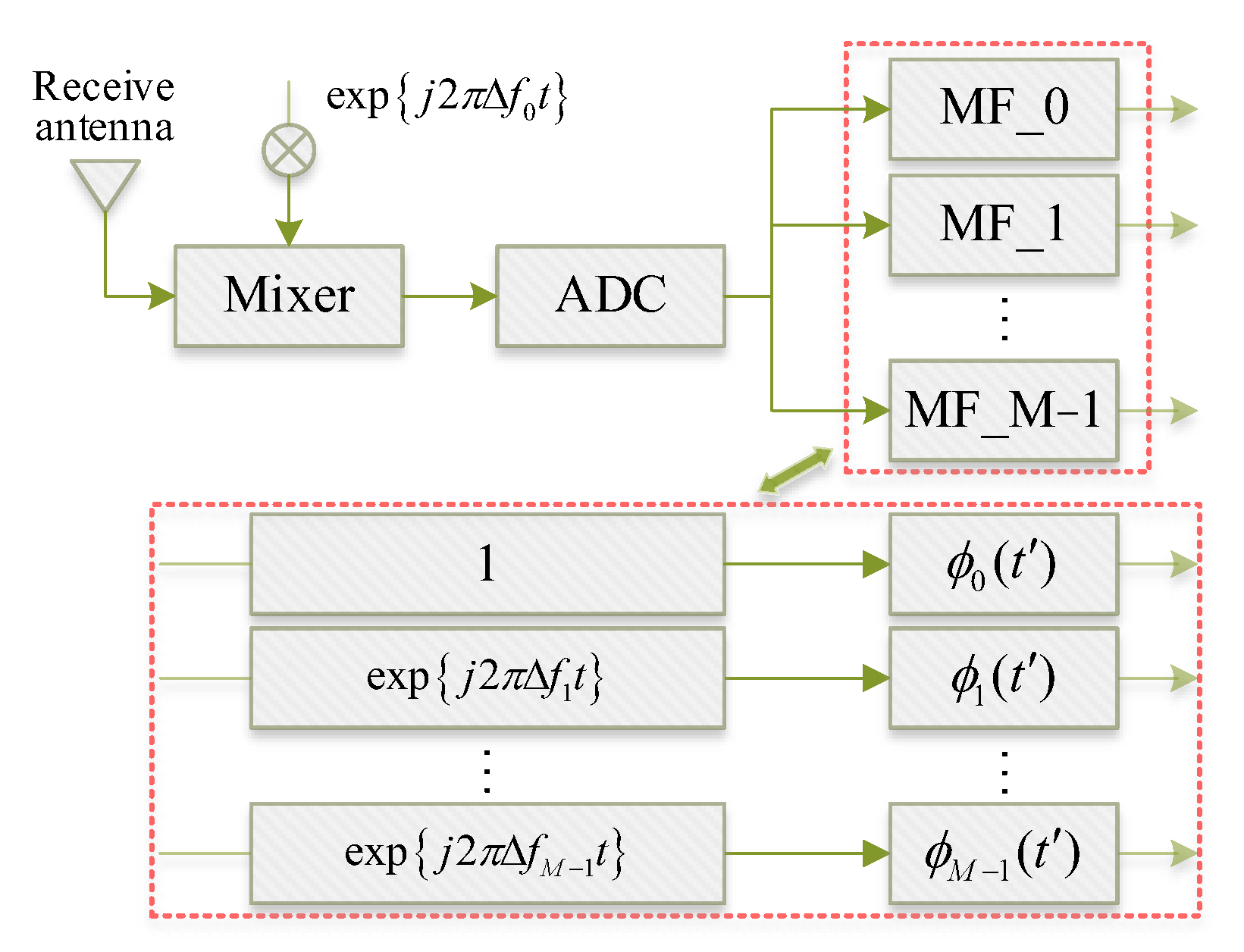
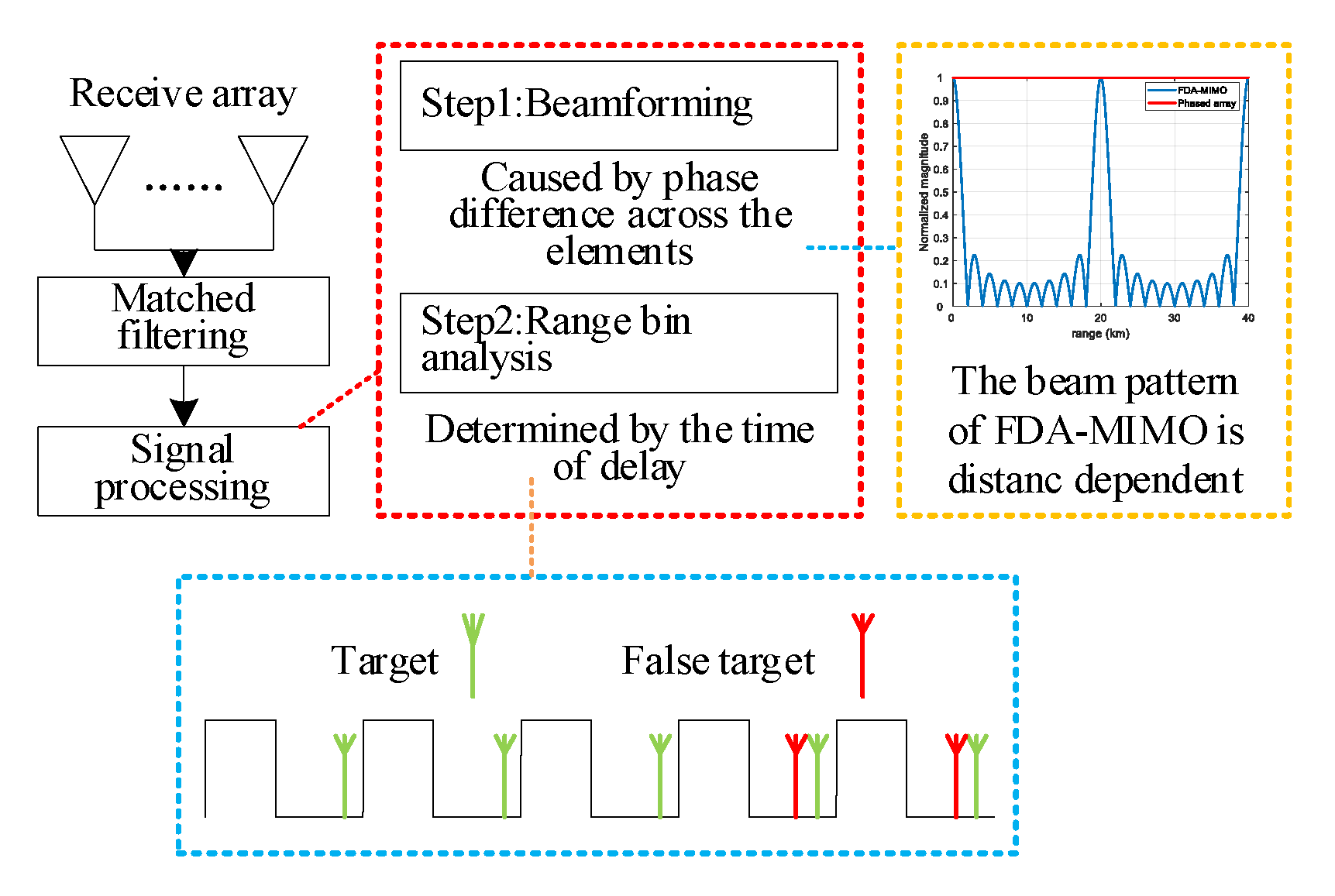
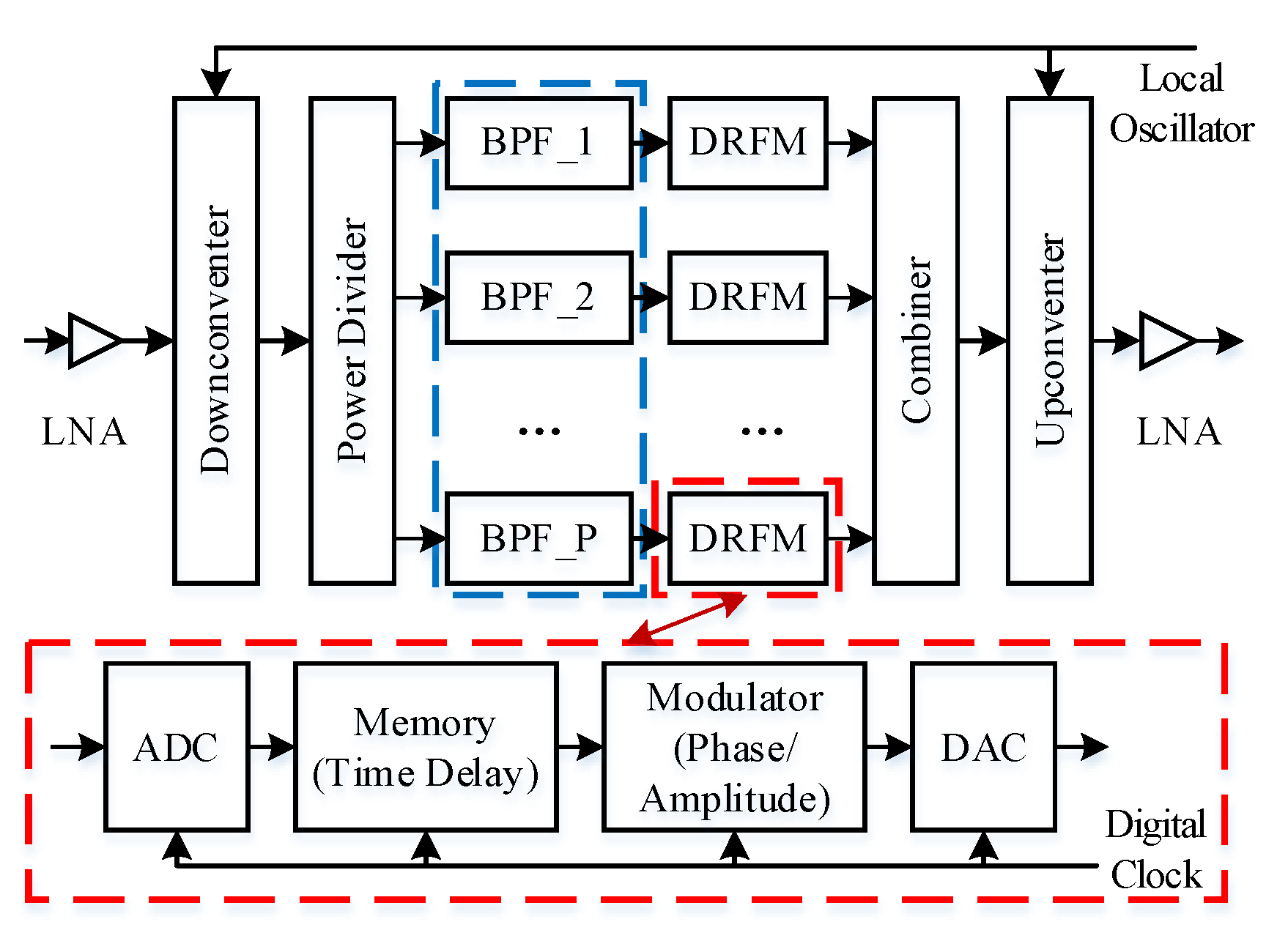
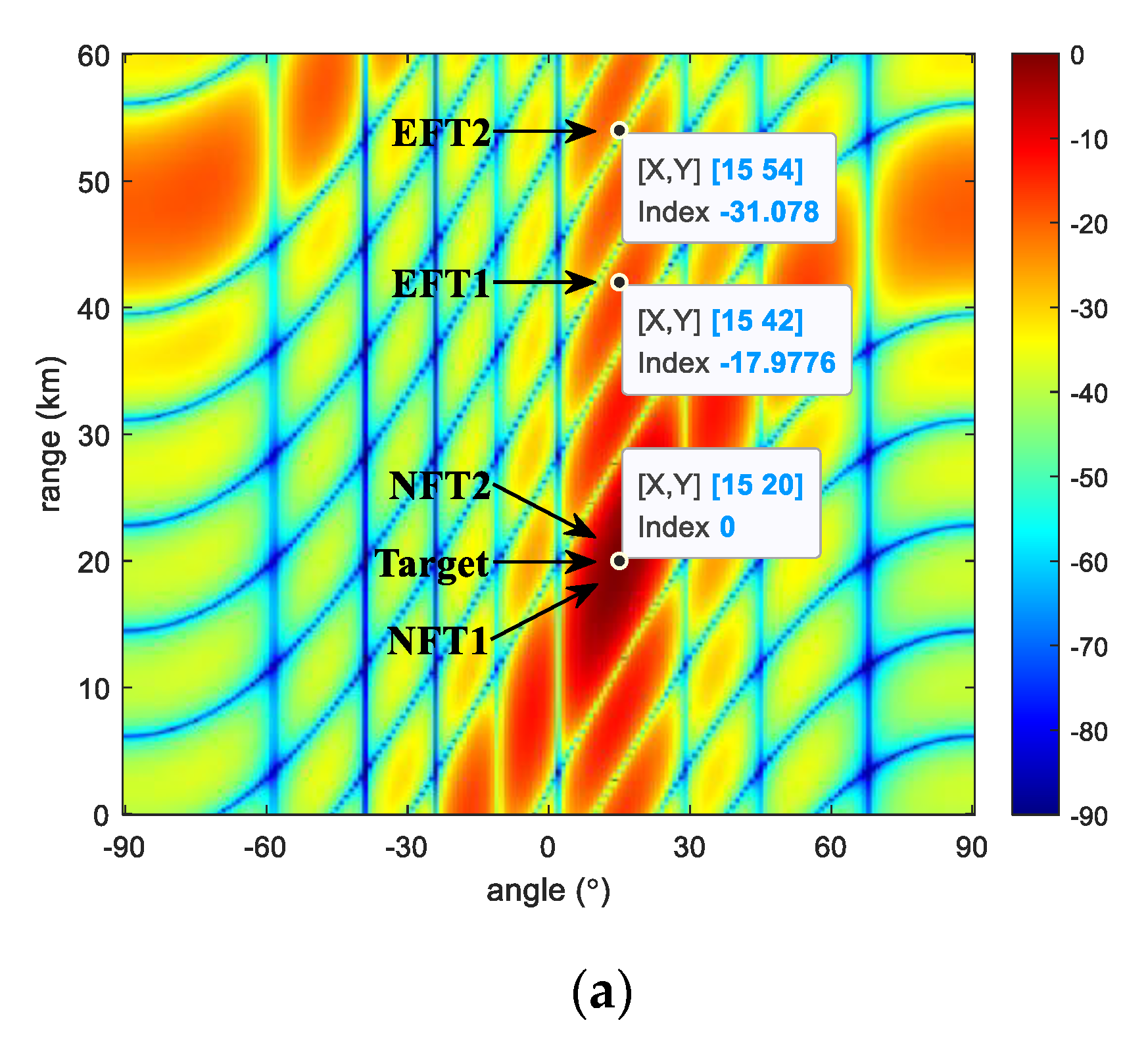

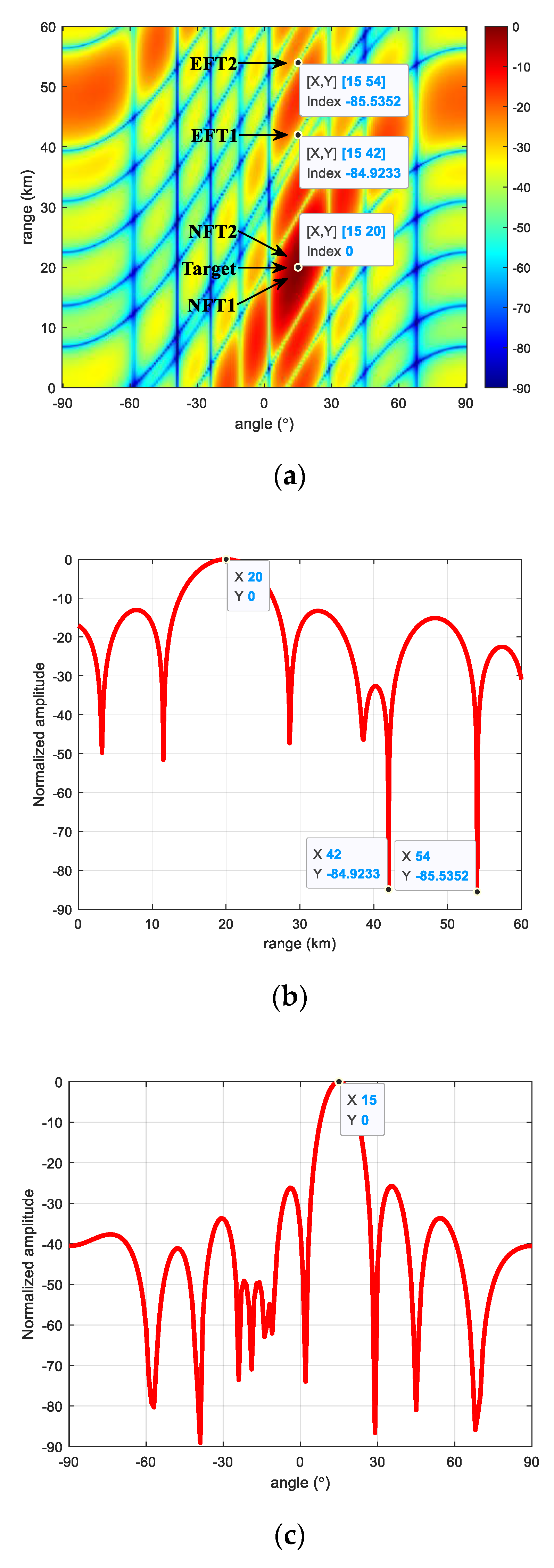
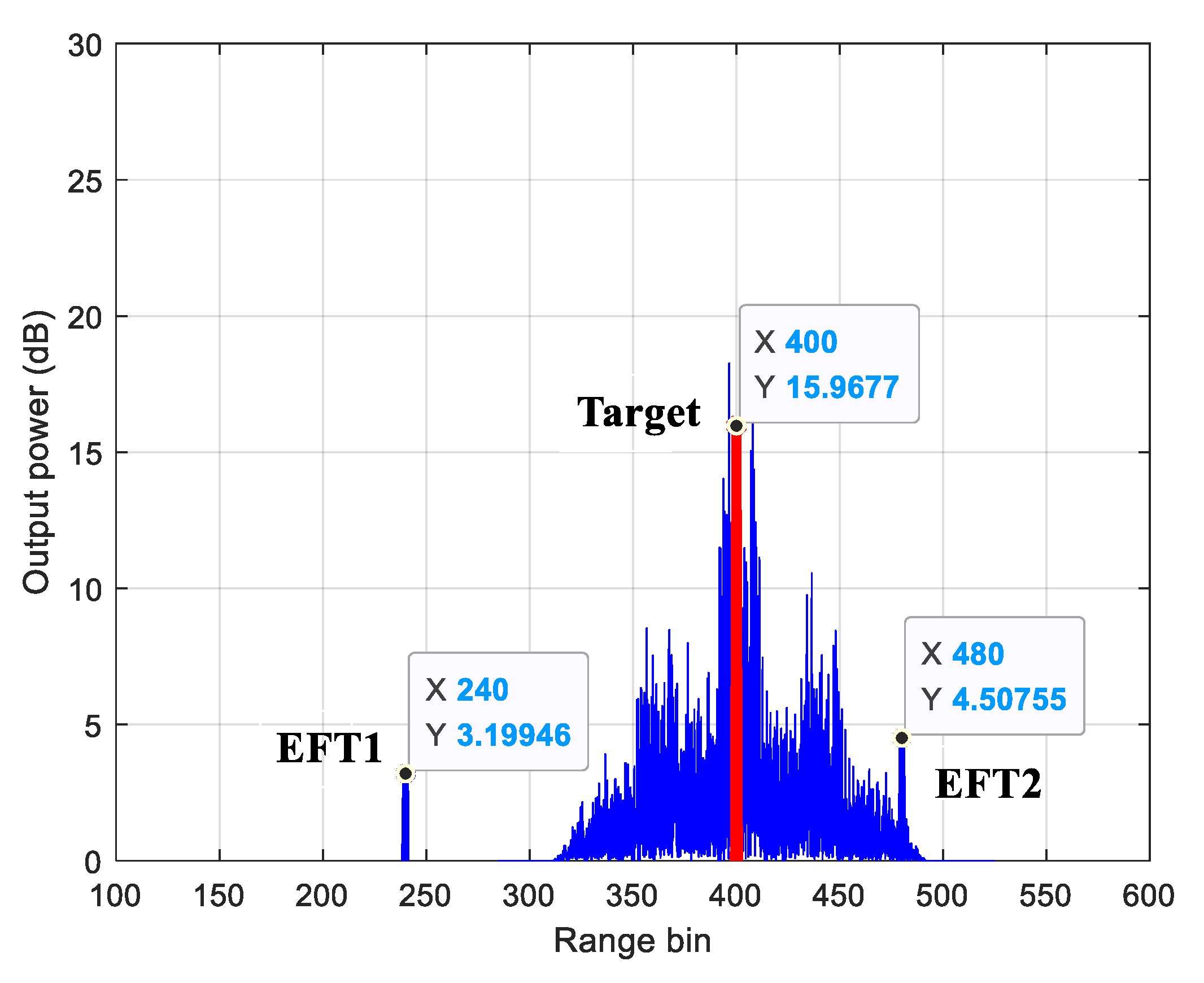
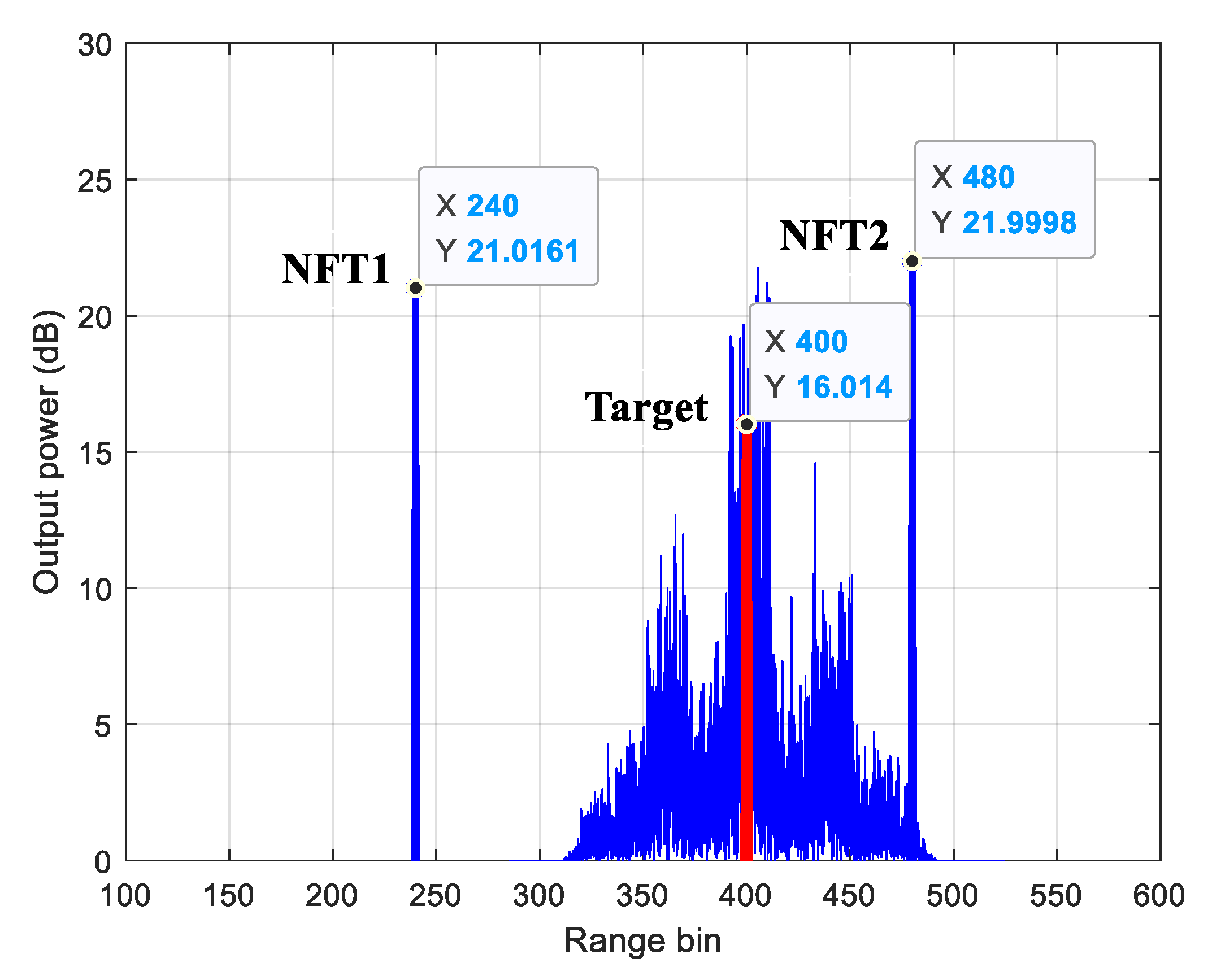

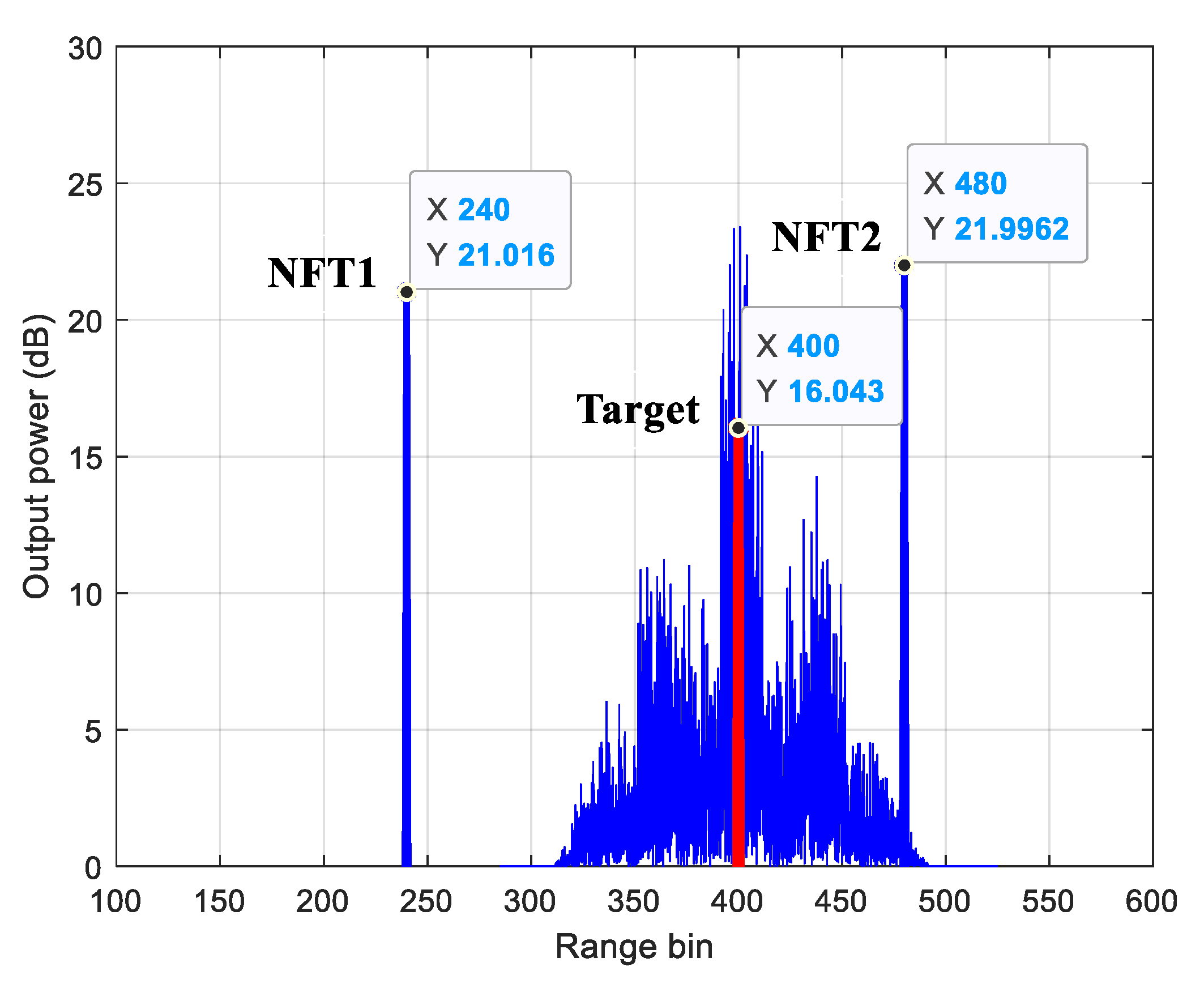


| Parameter | Value | Parameter | Value |
|---|---|---|---|
| Carrier frequency | Frequency offset | ||
| Target location | Pulse repetition period | ||
| Elements number | Number of range bin | ||
| Target time delay | Input SNR | ||
| EFT1 time delay | NFT1 time delay | ||
| EFT2 time delay | NFT2 time delay |
| dB | 20 km | 42 km | 54 km |
|---|---|---|---|
| non-adaptive beamforming | 0 | −17.9776 | −31.078 |
| range-angle two-dimensional MVDR adaptive beamforming | 0 | −84.9233 | −85.5253 |
Publisher’s Note: MDPI stays neutral with regard to jurisdictional claims in published maps and institutional affiliations. |
© 2022 by the authors. Licensee MDPI, Basel, Switzerland. This article is an open access article distributed under the terms and conditions of the Creative Commons Attribution (CC BY) license (https://creativecommons.org/licenses/by/4.0/).
Share and Cite
Chen, Y.; Tian, B.; Wang, C.; Gong, J.; Zhao, Y. Research on the Compound Jamming Method against FDA-MIMO Beamforming. Appl. Sci. 2022, 12, 9448. https://doi.org/10.3390/app12199448
Chen Y, Tian B, Wang C, Gong J, Zhao Y. Research on the Compound Jamming Method against FDA-MIMO Beamforming. Applied Sciences. 2022; 12(19):9448. https://doi.org/10.3390/app12199448
Chicago/Turabian StyleChen, Yang, Bo Tian, Chunyang Wang, Jian Gong, and Yingjian Zhao. 2022. "Research on the Compound Jamming Method against FDA-MIMO Beamforming" Applied Sciences 12, no. 19: 9448. https://doi.org/10.3390/app12199448




